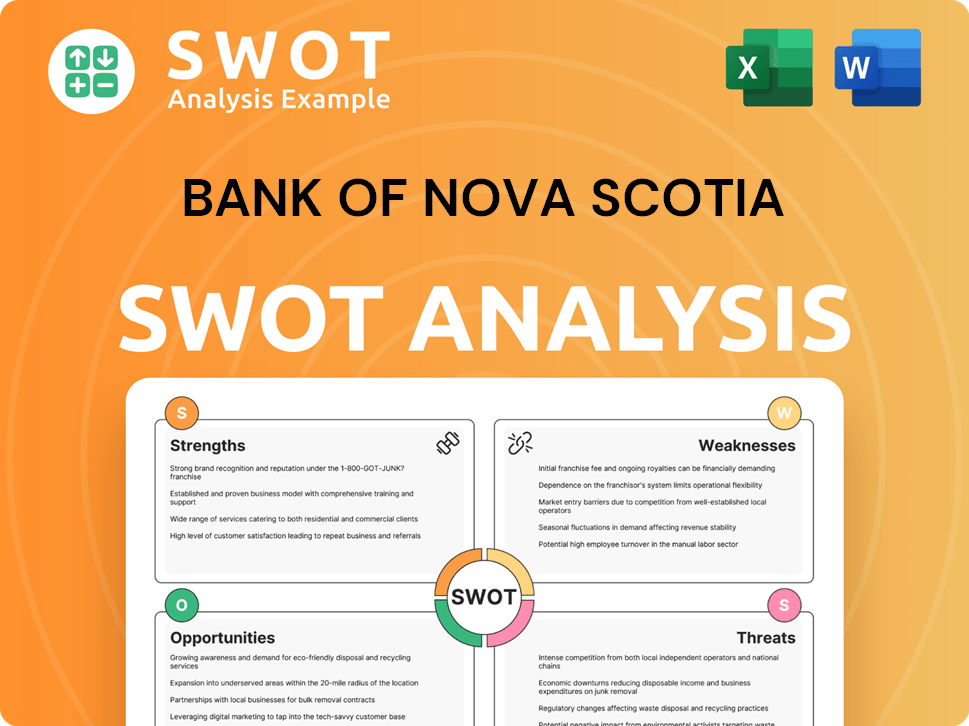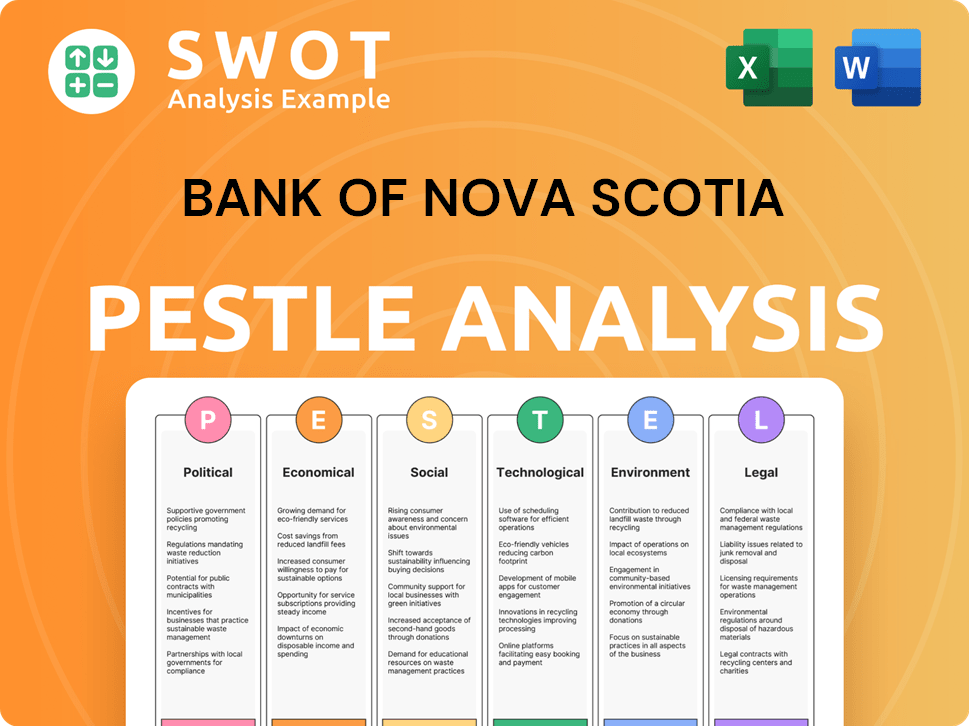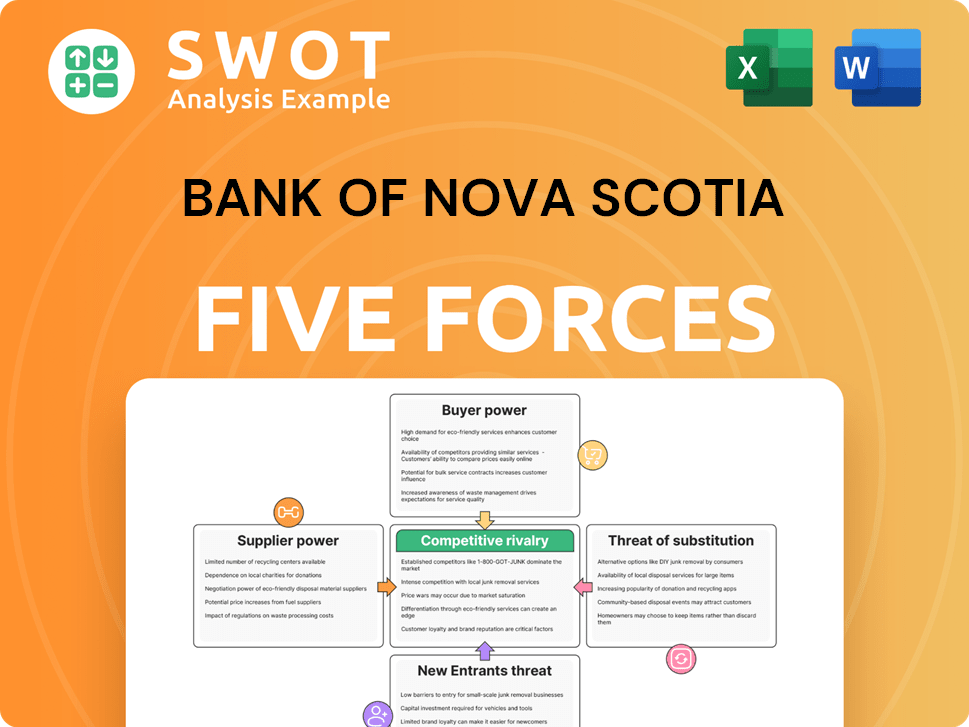Bank of Nova Scotia Bundle
How Will Bank of Nova Scotia Navigate the Future?
In today's dynamic financial world, understanding the growth trajectory of major players like Bank of Nova Scotia (BNS) is crucial. Founded in 1832, Scotiabank has evolved from a regional bank to a global financial services provider. This article examines Scotiabank's Bank of Nova Scotia SWOT Analysis and its strategic roadmap for sustained success.

Scotiabank's future prospects are intricately linked to its ability to adapt and innovate within the competitive financial services industry. This analysis will explore Scotiabank's strategic initiatives, technological advancements, and financial projections, providing insights into its long term growth potential. We'll also examine how BNS plans to leverage its international presence and customer experience strategy to drive profitability and maintain market share in the coming years, considering factors like risk management and sustainable growth strategy.
How Is Bank of Nova Scotia Expanding Its Reach?
The Bank of Nova Scotia (BNS) is strategically focused on expanding its business, both geographically and through enhancements to its products and services. This growth strategy includes optimizing capital allocation and focusing on markets with the greatest potential for profitable growth and operational efficiency. The bank's approach involves a recalibrated international strategy, with a strong emphasis on its operations in Canada, the United States, and the Pacific Alliance countries.
Scotiabank is streamlining its international operations, including the sale of non-core banking operations, to concentrate on its key markets. This strategic realignment aims to create a more focused and efficient global footprint, as demonstrated by its activities in fiscal year 2024. Domestically, the bank is investing in digital offerings and enhancing customer experience to attract new clients and deepen relationships with existing ones.
The bank actively explores opportunities in wealth management and commercial banking, recognizing these as high-growth areas. Strategic partnerships with fintech companies remain a viable avenue for integrating new technologies and capabilities. For more insights, you can explore the Target Market of Bank of Nova Scotia.
Scotiabank has been actively optimizing its international banking portfolio. This involves strategic divestitures and a focus on key markets. For example, the sale of its banking operations in El Salvador in fiscal year 2024 aimed to streamline its international presence.
The bank is investing heavily in digital offerings and enhancing customer experience. This includes the continuous evolution of its mobile banking platforms and online services. The goal is to meet the changing preferences of Canadian consumers and improve service delivery.
Scotiabank is targeting high-growth areas such as wealth management and commercial banking. This strategic focus is designed to capitalize on emerging market trends and increase profitability. The bank also considers strategic partnerships with fintech companies.
Strategic partnerships and acquisitions, particularly with fintech companies, are part of Scotiabank's strategy. Although recent acquisitions have focused on portfolio optimization, the bank continues to explore opportunities to integrate new technologies and capabilities. This approach helps to enhance its competitive position.
Scotiabank's expansion initiatives are multifaceted, encompassing geographical expansion, digital transformation, and strategic partnerships. These initiatives are designed to drive sustainable growth and enhance shareholder value. The bank's focus on key markets and efficient capital allocation is central to its strategy.
- Geographic Focus: Prioritizing operations in Canada, the United States, and the Pacific Alliance countries.
- Digital Investments: Continuous improvement of mobile banking platforms and online services.
- Strategic Partnerships: Exploring opportunities with fintech companies to integrate new technologies.
- Portfolio Optimization: Streamlining international operations through strategic divestitures.
Bank of Nova Scotia SWOT Analysis
- Complete SWOT Breakdown
- Fully Customizable
- Editable in Excel & Word
- Professional Formatting
- Investor-Ready Format

How Does Bank of Nova Scotia Invest in Innovation?
Scotiabank, also known as Bank of Nova Scotia (BNS), is actively leveraging technology and innovation as key drivers for its growth strategy. This approach focuses on digital transformation across all its operations, aiming to enhance customer experiences and improve efficiency. The bank's commitment to innovation is evident in its significant investments in both in-house development and strategic collaborations within the financial services sector.
The core of Scotiabank's strategy involves the ongoing modernization of its digital platforms. The bank is focusing on providing seamless and intuitive experiences for its customers across all banking channels. This includes initiatives to enhance mobile banking, online platforms, and other digital touchpoints, making banking easier and more accessible for its customers.
Scotiabank is also heavily focused on using data analytics and artificial intelligence (AI) to personalize customer offerings, improve risk management, and enhance operational efficiency. For example, the bank is exploring the use of AI for fraud detection and to provide tailored financial advice to its clients. This data-driven approach helps Scotiabank to better understand customer needs and preferences, and to offer more relevant and effective financial solutions.
Scotiabank's digital transformation strategy is a key element of its growth strategy. The bank has been investing heavily in technology to improve its digital capabilities, aiming to provide better services to its customers. This includes upgrades to its mobile banking app and online platforms, as well as the implementation of new technologies like AI and cloud computing.
The bank is using data analytics and AI to personalize customer offerings and improve risk management. Scotiabank is exploring AI for fraud detection and providing tailored financial advice. By leveraging these technologies, Scotiabank aims to enhance operational efficiency and provide better customer service.
Scotiabank is exploring the use of cloud computing to improve the scalability and resilience of its IT infrastructure. This move is expected to enhance the bank's ability to handle increased transaction volumes and provide more reliable services. Cloud technology also supports the bank's efforts to reduce operational costs.
Scotiabank's technological solutions are designed to be customer-centric, focusing on improving the overall banking experience. The bank aims to provide seamless and intuitive digital experiences across all channels. This focus on customer needs is central to Scotiabank's strategy to maintain a competitive edge in the financial services market.
The bank's digital sales continue to grow, indicating successful customer adoption of its digital channels. This growth reflects the effectiveness of Scotiabank's digital transformation efforts and the increasing preference of customers for online and mobile banking solutions. This trend is crucial for BNS's future prospects.
Scotiabank's commitment to digital transformation is evident in its continued investment in technology. These investments are seen as crucial for maintaining a competitive edge and meeting evolving customer expectations in the digital age. This ongoing investment supports the bank's long-term growth potential.
Scotiabank's approach to innovation and technology is also influenced by the competitive landscape. To understand the competitive environment, it's useful to examine the Competitors Landscape of Bank of Nova Scotia. This includes the bank's efforts in exploring cutting-edge technologies, such as cloud computing, to improve the scalability and resilience of its IT infrastructure. While specific patents or industry awards for recent breakthroughs are not always prominently highlighted in public statements, Scotiabank consistently emphasizes its efforts in digital banking and customer-centric technological solutions. The bank's digital sales continue to grow, indicating a successful adoption of its digital channels by customers. Scotiabank's commitment to digital transformation is evident in its continued investment in technology, which is seen as crucial for maintaining a competitive edge and meeting evolving customer expectations in the digital age. The bank's strategic initiatives are designed to improve its financial performance and expand its market share.
Bank of Nova Scotia PESTLE Analysis
- Covers All 6 PESTLE Categories
- No Research Needed – Save Hours of Work
- Built by Experts, Trusted by Consultants
- Instant Download, Ready to Use
- 100% Editable, Fully Customizable

What Is Bank of Nova Scotia’s Growth Forecast?
Scotiabank's financial outlook is shaped by its strategic focus on optimizing its business mix and driving efficiency. The bank's performance in the first quarter of fiscal year 2024 shows resilience, with an adjusted net income of $2,204 million, or $1.69 per diluted share. This demonstrates the bank's ability to navigate the financial landscape effectively.
The Canadian Banking segment reported a net income of $1,215 million, an increase from the previous quarter, driven by higher net interest income and non-interest income. International Banking also performed well, with an adjusted net income of $715 million, particularly from its key Pacific Alliance markets. These results highlight the strength of Scotiabank's diversified operations.
Looking ahead, Scotiabank is targeting sustained earnings growth through disciplined expense management and continued revenue diversification. The bank is focused on improving its efficiency ratio and maintaining strong capital levels to support future investments and manage economic uncertainties. For more insights into the bank's structure, consider reading about the Revenue Streams & Business Model of Bank of Nova Scotia.
Scotiabank's financial performance in Q1 2024 showed an adjusted net income of $2,204 million. This reflects the bank's ability to maintain profitability despite market challenges. The Canadian Banking segment's net income also increased, demonstrating strong domestic performance.
The bank is focused on disciplined expense management and revenue diversification. These initiatives are crucial for achieving sustained earnings growth. Scotiabank's strategy includes optimizing its business mix to enhance profitability.
Scotiabank's common equity tier 1 (CET1) capital ratio stood at 13.2% as of January 31, 2024. This strong capital position supports future investments and growth. Maintaining strong capital levels is a key aspect of the bank's financial strategy.
Analysts generally anticipate steady, moderate growth in earnings and revenue. This reflects the stable but challenging banking environment. Scotiabank's focus on capital allocation to higher-return businesses is key.
Scotiabank's future prospects are tied to its ability to execute its growth strategy. The bank's focus on international expansion, particularly in the Pacific Alliance markets, is expected to contribute to its long-term growth potential. The bank is also investing in digital transformation to improve customer experience and operational efficiency.
- BNS aims for sustained earnings growth.
- The bank is focused on improving its efficiency ratio.
- Capital allocation to higher-return businesses is a key strategy.
- Digital transformation is a priority for Scotiabank.
Bank of Nova Scotia Business Model Canvas
- Complete 9-Block Business Model Canvas
- Effortlessly Communicate Your Business Strategy
- Investor-Ready BMC Format
- 100% Editable and Customizable
- Clear and Structured Layout

What Risks Could Slow Bank of Nova Scotia’s Growth?
The Bank of Nova Scotia's (BNS) growth strategy faces several potential risks and obstacles inherent in the financial services sector. Market competition, both from traditional banks and agile fintech companies, presents a continuous challenge to maintaining and increasing market share. Regulatory changes and the volatile geopolitical landscape in key international markets, such as those in Latin America, also pose significant risks.
Technological disruption and cybersecurity threats are ongoing concerns, requiring substantial investment to keep pace with rapid advancements and protect customer data. The bank's future prospects and financial performance are closely tied to its ability to adapt and manage these challenges effectively. A comprehensive risk management framework, including business line and geographical diversification, is essential for mitigating these risks.
Emerging risks, such as the increasing impact of climate change and the complexity of global regulatory frameworks, are also monitored and integrated into risk assessments. The bank's resilience is demonstrated through its focus on prudent risk management and its ability to adapt to changing market conditions. For more insights, you can explore Owners & Shareholders of Bank of Nova Scotia.
The financial services industry is highly competitive, with both established banks and innovative fintech companies vying for market share. This competition can impact BNS's profitability and growth potential. The rise of digital banking and evolving customer expectations require continuous innovation and investment to remain competitive. The bank must strategically position itself to compete effectively within this dynamic environment, including strategies such as customer experience and digital transformation.
Regulatory changes, particularly in areas like data privacy, consumer protection, and capital requirements, can increase compliance costs and limit operational flexibility. The bank must navigate an evolving regulatory landscape to maintain its operations and adapt to new rules. Compliance with these regulations can involve substantial investments in technology, personnel, and processes, affecting the bank's financial performance and strategic initiatives. These regulations can vary significantly across different geographic regions, increasing the complexity of compliance efforts.
Economic volatility and geopolitical instability, particularly in key international markets, pose risks to the bank's international banking segment. Fluctuations in currency exchange rates, political risks, and economic downturns can impact the bank's financial performance and strategic initiatives. The bank must manage its exposure to these risks through diversification and prudent risk management practices. The bank's international operations are subject to various economic cycles.
Technological advancements and cybersecurity threats present significant challenges. The bank must continuously invest in technology to keep pace with rapid changes and protect customer data. Cybersecurity breaches can lead to financial losses, reputational damage, and regulatory penalties. The bank's ability to adapt to these technological advancements is crucial to its future prospects and long-term growth potential. The evolving threat landscape requires constant vigilance and investment in robust security measures.
Bank of Nova Scotia Porter's Five Forces Analysis
- Covers All 5 Competitive Forces in Detail
- Structured for Consultants, Students, and Founders
- 100% Editable in Microsoft Word & Excel
- Instant Digital Download – Use Immediately
- Compatible with Mac & PC – Fully Unlocked

Related Blogs
- What are Mission Vision & Core Values of Bank of Nova Scotia Company?
- What is Competitive Landscape of Bank of Nova Scotia Company?
- How Does Bank of Nova Scotia Company Work?
- What is Sales and Marketing Strategy of Bank of Nova Scotia Company?
- What is Brief History of Bank of Nova Scotia Company?
- Who Owns Bank of Nova Scotia Company?
- What is Customer Demographics and Target Market of Bank of Nova Scotia Company?
Disclaimer
All information, articles, and product details provided on this website are for general informational and educational purposes only. We do not claim any ownership over, nor do we intend to infringe upon, any trademarks, copyrights, logos, brand names, or other intellectual property mentioned or depicted on this site. Such intellectual property remains the property of its respective owners, and any references here are made solely for identification or informational purposes, without implying any affiliation, endorsement, or partnership.
We make no representations or warranties, express or implied, regarding the accuracy, completeness, or suitability of any content or products presented. Nothing on this website should be construed as legal, tax, investment, financial, medical, or other professional advice. In addition, no part of this site—including articles or product references—constitutes a solicitation, recommendation, endorsement, advertisement, or offer to buy or sell any securities, franchises, or other financial instruments, particularly in jurisdictions where such activity would be unlawful.
All content is of a general nature and may not address the specific circumstances of any individual or entity. It is not a substitute for professional advice or services. Any actions you take based on the information provided here are strictly at your own risk. You accept full responsibility for any decisions or outcomes arising from your use of this website and agree to release us from any liability in connection with your use of, or reliance upon, the content or products found herein.